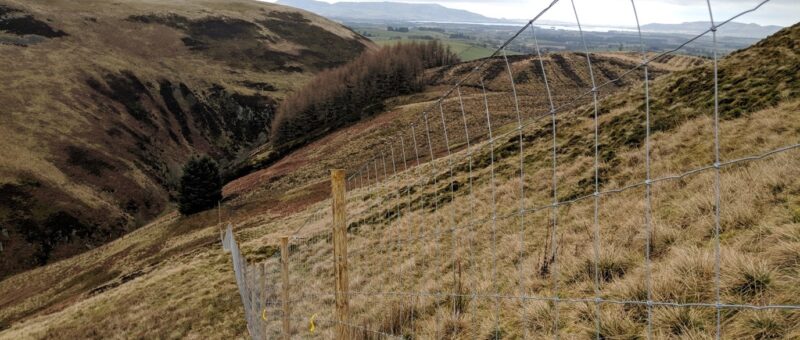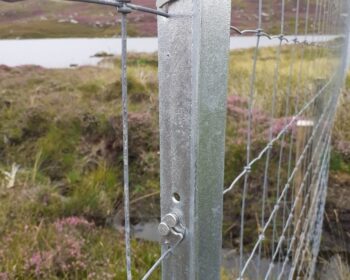What does the future look like for forest fencing?
25 March 2024
Deer play a key role in shaping habitats across Scotland, and if not carefully managed, they can be a persistent source of trouble for anyone seeking to establish new woodlands. Whilst deer are often considered the largest threat to new woodlands, there are many other herbivores that can prove equally problematic to trees. Rabbits and hares can cause decimation of new woodland blocks in early years, and similarly sheep, goats and cattle can undo years of hard-won establishment in a new forest within just a few hours if inadvertently left to graze young woods indiscriminately.
As such, many establishing woodlands depend on forest fencing for their survival. Good forest fencing plays a pivotal role in enabling different land use objectives such as farming and forestry to be achieved in close proximity to each other across Scotland’s landscapes.
Costs
As surmised by the Forestry Commission Bulletin “Forest Fencing” from 1992:
“Any forest fence is a compromise between expense and effectiveness.”
Costs related to forest fencing have risen considerably in recent times. Both fencing wire and timber post prices have increased due to supply chain challenges, demand, costs of raw materials (steel, timber) and costs of production/delivery. The costs of construction have also risen due to contractor shortages, cost of plant and machinery/labour, fuel and other factors.
These socio-economic pressures have had a significant impact on the feasibility of many new woodland creation or forest fencing projects, with reports of rising numbers of woodland creation projects which require fence construction struggling to achieve economic viability.
Forestry Grant Scheme capital item grants for new Deer Fencing are now offered at a single rate of £9.90 per metre (after the High Cost Deer Fence target area was expanded in December 2023 to cover all of Scotland), whilst the actual cost of deer fencing can routinely exceed £16 per metre in many areas, soaring to over £23 per metre for more challenging sites, often found in remote Highland areas.
In addition to being more expensive, the effective lifespan of current fencepost offerings can be substantially shorter than previously achieved due to a change in the timber preservative options available to use.
Preservative treatments
Prior to 1st September 2006, Copper Chromium Arsenic (CCA) preservative treatments were commonly utilised to prolong the effective life of forestry fencing timber posts. After these CCA preservatives were banned from use due to the associated health risks, many landowners have seen a decrease in the effective lifespan of timber fence posts on the market, with fence posts sometimes failing within the five-year period of undertaking despite the increasing expense of installing fences.
With landowners, foresters, and farmers having faced rising costs of fencing against an unchanged grant rate and decreasing effective lifespan of preservative-treated timber, many are either returning to time-proven techniques of preserving fencing such as creosote-based solutions, or are seeking new innovative alternatives.
Whilst creosote-treated strainers and posts are time-proven to last over 50 years in some cases (telegraph poles are typically creosote-pressure treated Scots Pine), these creosoted posts are unpleasant to work with, frequently leaching persistent, bio-accumulative and toxic chemicals into their environs, and have significant health impacts as a recognised “probable human carcinogen”. Creosote-treated fencing products are also now facing an uncertain future in the UK, with creosoted timber already banned for equestrian and agricultural fencing use across the EU in 2023.
This ban on both CCA preservatives, and questionable future for Creosote-treated timbers in the UK, has the potential to greatly restrict the already limited freedom of choice for consumers within the market, and for many fence post products, shorten the effective lifespan of new fences considerably.
Alternatives
Farmers, foresters, and landowners are looking to explore other solutions, and these include new timber preservative treatments such as Tanacote, metal fencing systems such as Clipex/TripleX and Hampton Fencing posts, or plastic posts such as Enduraposts or LL Plastic posts.
Whilst plastic posts are still limited in their uptake for anything larger than stock fencing, metal fencing solutions have been adopted across the UK to great effect for both stock and deer fencing projects. Metal fence posts have now been approved for use in England by both DEFRA and by Forestry Commission England (https://www.gov.uk/countryside-stewardship-grants/fencing-fg1 and https://www.gov.uk/countryside-stewardship-grants/deer-fencing-fg9), but are still (as of March 2024) under review for use on Forestry Grant schemes in Scotland.

With costs for metal fencing now understood to be comparable to that of traditional wooden post and wire net construction, but with potential for a 30 year service life compared to a 10 year life expectancy with some wooden constructions, we may see more of these fencing systems being adopted across Scotland. Erection times for metal fence posts can be far faster, with a narrower post profile allowing rapid assembly using mechanical post drivers, and with some metal post products incorporating rapid “click” wire connections, negate the need for stapling. Similarly, some projects have implemented the use of either plastic or concrete strainers on their fences, with the aim of extending the viable lifespan of their fencing solutions.
Any forestry project contemplating the use of timber post alternatives in grant-funded fencing should first ensure compliance with the specific grant criteria for their chosen option prior to ordering materials - contact your local Scottish Forestry Conservancy if in any doubt.
Are there any viable alternatives to forest fencing?
This all comes down to the land use objectives specific to the individual site and project. If there is a requirement to maintain grazing of livestock alongside new/establishing woodlands, alternatives to forest fencing are quite limited. Electric scare-wires and temporary fencing are potentially suitable for short-term exclusion of stock such as in mob-grazing systems, but are rarely suitable for the long-term needs of establishing woodlands.
Similarly, virtual fencing solutions using smart collar technology may prove more costly/time-consuming over longer duration establishment periods of woodlands than a traditional forest fence. Essentially, if livestock are grazing alongside woodlands, fencing will almost always be required to keep these two differing land uses separate. It is very rare though that livestock pressure is the only factor when considering woodland grazing - deer, rabbits or hare are frequently found alongside stock, and are unfortunately harder to deter.
Individual tree protection is possible using tree shelters (tubes and stakes), and this is preferable on many smaller sites now where fencing would be prohibitively expensive, such as along riparian strips. Whilst tree shelters can be cheaper to install initially than fencing for small areas, it’s worth remembering the issue of redundant materials. Once the trees are established, either the shelters need to be removed and recycled to prevent microplastics from breaking down and entering soils and waterways, which can be time-consuming and expensive, or the shelters need to be made of biodegradable materials which are capable of breaking down fully on site without creating pollution or litter problems.
Similarly, deer repellents can be considered for smaller areas or those which would be too challenging to fence (for example when restocking or planting small patches within a larger established woodland). Repellents such as Trico are popular on the continent, and consist of a substance that is repulsive to deer sprayed onto the branch tips of trees at least twice a year. This repellent does not work on hares or rabbits though, so if browsing damage is caused by more than just deer this solution will not be effective.
Lastly, there is a returning focus at present within the forestry sector for establishment of forests through either planting or natural regeneration on a landscape scale, without the need for fences. Whilst this may be the ultimate ideal for many, most of our landscapes have been significantly degraded by over a century of sustained grazing by livestock and/or deer, and the long recovery of these landscapes will only be possible if grazing pressure is either greatly reduced or removed entirely from target areas. Livestock grazing is conducted in a far more responsible manner now than in the 1800s, but bringing deer populations back to a level where trees can establish without fencing is far harder.
This population management approach is only effective if completed on a landscape scale with wide collaboration, and vitally with sustained and consistent engagement from all neighbouring landowners. Whilst landscape-scale restoration of woodlands achieved through sustainable population levels of deer may be a long-term goal for many, there is still a long way to go before this is achievable. Until then, forest fencing (in some format) will continue to play a key role in achieving new woodlands alongside multiple land use objectives within our landscapes.
Ben Law, Senior Forestry Consultant
Sign up to the FAS newsletter
Receive updates on news, events and publications from Scotland’s Farm Advisory Service
